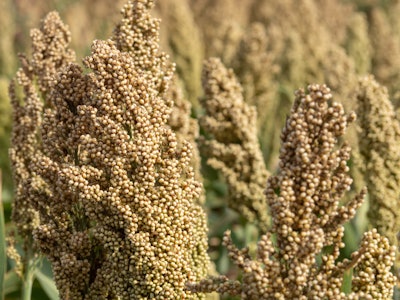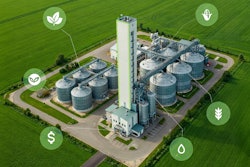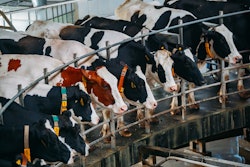
In today's agricultural landscape, "ancient grains" — resilient, nutrient-packed crops that have fed humans and animals for thousands of years — are experiencing renewed interest. Unlike highly refined, high-input grains that dominate modern agriculture, ancient grains such as millet, amaranth, teff and sorghum are making a strong return, delivering superior nutrition, climate adaptability and reduced environmental impact.
Sorghum stands out among these hardy grains, particularly for animal feed applications. With its combination of nutritional density, sustainability and versatility, sorghum offers compelling advantages for poultry, dairy, cattle and swine producers.
Ancient roots, modern relevance
Cultivated for more than 4,000 years, sorghum thrives in regions where other grains struggle. Originating in Africa, it has spread globally — from the U.S. Plains to the drylands of Australia and South Africa. Farmers have long valued sorghum for its resilience: it grows in arid, low-fertility soils, tolerates heat and drought, and requires significantly less water than corn or wheat.
This matters in an era of unpredictable weather patterns and growing pressure for sustainable farming practices. Sorghum's deep root system and efficient water use make it ideal for regions facing limited rainfall or degraded soils. It's a crop that demands little while delivering substantial returns.
Nutritional profile for livestock
From a nutritional standpoint, sorghum is a livestock feed powerhouse. It provides energy, protein and essential micronutrients, making it a viable alternative or complement to traditional feed grains such as corn or barley.
- Energy-rich feed: With high starch levels, sorghum offers comparable energy content to maize, providing excellent fuel for growth, milk production and overall animal performance.
- Balanced protein: Depending on variety, sorghum contains 9% to 12% protein, sufficient to support muscle development and overall health in most livestock species.
- Minerals and antioxidants: Many sorghum varieties contain valuable minerals including iron, magnesium and phosphorus. Some varieties feature antioxidant compounds that may contribute to animal health and disease resistance.
- Improved palatability: Modern breeding programs have developed low- or no-tannin sorghum varieties, improving digestibility and palatability for all livestock types.
Producers who have introduced sorghum into feed rations report animals adapt easily and perform well on the grain.
Environmental advantages
One of sorghum's most significant attributes is its low environmental footprint. Unlike corn and wheat, which often require substantial fertilizer and irrigation inputs, sorghum excels at resource efficiency:
- Water conservation: Sorghum uses up to 30% less water than corn — critical in drought-prone regions.
- Reduced inputs: The crop thrives without heavy fertilizer applications, reducing runoff and soil degradation.
- Soil health: Sorghum's robust root system prevents erosion, adds organic matter and improves soil structure over time.
- Climate resilience: The grain's hardiness results in fewer crop losses during heat waves or dry spells, helping farmers maintain productivity in challenging conditions.
Sorghum offers an environmentally sound alternative that complements regenerative farming systems. It allows producers to maintain yield and feed quality while reducing overall environmental costs — benefiting animals, operations and the planet.
Strategic feed choice
As agriculture moves toward sustainability and circular economies, sorghum fits naturally into conversations about animal nutrition's future. It supports a balanced approach where producers can deliver high-quality feed without overexploiting natural resources.
Replacing even a portion of feed rations with sorghum can reduce input costs, diversify cropping systems and build resilience against drought or market fluctuations. Sorghum is no longer just an alternative grain — it's a strategic choice for livestock producers balancing performance with sustainability.
Beyond direct feed applications, sorghum byproducts including bran and distillers grains can be utilized for bioenergy or soil enrichment, further enhancing sustainability.
Forward-thinking agriculture
Some of agriculture's most innovative solutions come from the past. Ancient grains like sorghum demonstrate that resilience, nutrition and sustainability can work together. By leveraging these time-tested crops, modern farming can address challenges — from water scarcity to climate change — through smarter, more adaptable strategies.
Producers who choose sorghum aren't just feeding livestock — they're investing in a sustainable future and building food and feed systems that work with nature.
Bottom line
Sorghum proves ancient doesn't mean outdated. This grain is built for the future: nutrient-dense, hardy and environmentally friendly. For livestock producers, it delivers performance and peace of mind through strong animal performance, healthier soils and reduced environmental stress.
So, whether you’re rethinking your feed strategy or just curious about greener options, consider giving sorghum a place in your rotation. It’s one ancient grain that’s right at home in modern agriculture and feeding animals today while protecting the resources they’ll need tomorrow.
 Nate BlumCourtesy Sorghum United Foundation
Nate BlumCourtesy Sorghum United Foundation
Sorghum United Foundation is a global nonprofit advancing the use of sorghum and other traditional grains for food security, climate resilience and economic opportunity.



















